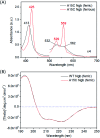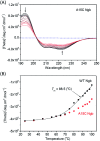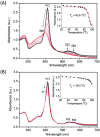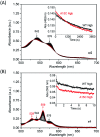Enhancement of protein stability by an additional disulfide bond designed in human neuroglobin
- PMID: 35520156
- PMCID: PMC9062612
- DOI: 10.1039/c8ra10390a
Enhancement of protein stability by an additional disulfide bond designed in human neuroglobin
Abstract
Human neuroglobin (Ngb) forms an intramolecular disulfide bond between Cys46 and Cys55, with a third Cys120 near the protein surface, which is a promising protein model for heme protein design. In order to protect the free Cys120 and to enhance the protein stability, we herein developed a strategy by designing an additional disulfide bond between Cys120 and Cys15 via A15C mutation. The design was supported by molecular modeling, and the formation of Cys15-Cys120 disulfide bond was confirmed experimentally by ESI-MS analysis. Molecular modeling, UV-Vis and CD spectroscopy showed that the additional disulfide bond caused minimal structural alterations of Ngb. Meanwhile, the disulfide bond of Cys15-Cys120 was found to enhance both Gdn·HCl-induced unfolding stability (increased by ∼0.64 M) and pH-induced unfolding stability (decreased by ∼0.69 pH unit), as compared to those of WT Ngb with a single native disulfide bond of Cys46-Cys55. Moreover, the half denaturation temperature (T m) of A15C Ngb was determined to be higher than 100 °C. In addition, the disulfide bond of Cys15-Cys120 has slight effects on protein function, such as an increase in the rate of O2 release by ∼1.4-fold. This study not only suggests a crucial role of the artificial disulfide in protein stabilization, but also lays the groundwork for further investigation of the structure and function of Ngb, as well as for the design of other functional heme proteins, based on the scaffold of A15C Ngb with an enhanced stability.
This journal is © The Royal Society of Chemistry.
Conflict of interest statement
There are no conflicts to declare.
Figures








Similar articles
-
The X-ray crystal structure of human A15C neuroglobin reveals both native/de novo disulfide bonds and unexpected ligand-binding sites.Proteins. 2022 May;90(5):1152-1158. doi: 10.1002/prot.26297. Epub 2022 Jan 10. Proteins. 2022. PMID: 34982478
-
An intramolecular disulfide bond designed in myoglobin fine-tunes both protein structure and peroxidase activity.Arch Biochem Biophys. 2016 Jun 15;600:47-55. doi: 10.1016/j.abb.2016.04.012. Epub 2016 Apr 23. Arch Biochem Biophys. 2016. PMID: 27117233
-
Disulfide bond influence on protein structural dynamics probed with 2D-IR vibrational echo spectroscopy.Proc Natl Acad Sci U S A. 2007 Dec 4;104(49):19309-14. doi: 10.1073/pnas.0709760104. Epub 2007 Nov 27. Proc Natl Acad Sci U S A. 2007. PMID: 18042705 Free PMC article.
-
Structural and (Pseudo-)Enzymatic Properties of Neuroglobin: Its Possible Role in Neuroprotection.Cells. 2021 Nov 30;10(12):3366. doi: 10.3390/cells10123366. Cells. 2021. PMID: 34943874 Free PMC article. Review.
-
Neuroglobin: From structure to function in health and disease.Mol Aspects Med. 2016 Dec;52:1-48. doi: 10.1016/j.mam.2016.10.004. Epub 2016 Nov 4. Mol Aspects Med. 2016. PMID: 27825818 Review.
Cited by
-
Evidence for a synergistic effect of post-translational modifications and genomic composition of eEF-1α on the adaptation of Phytophthora infestans.Ecol Evol. 2021 Mar 18;11(10):5484-5496. doi: 10.1002/ece3.7442. eCollection 2021 May. Ecol Evol. 2021. PMID: 34026022 Free PMC article.
-
Stabilization of Cereibacter sphaeroides Photosynthetic Reaction Center by the Introduction of Disulfide Bonds.Membranes (Basel). 2023 Jan 25;13(2):154. doi: 10.3390/membranes13020154. Membranes (Basel). 2023. PMID: 36837657 Free PMC article.
-
Improved single-cell genome amplification by a high-efficiency phi29 DNA polymerase.Front Bioeng Biotechnol. 2023 Jun 29;11:1233856. doi: 10.3389/fbioe.2023.1233856. eCollection 2023. Front Bioeng Biotechnol. 2023. PMID: 37456715 Free PMC article.
-
Site-specific incorporation of 19F-nulcei at protein C-terminus to probe allosteric conformational transitions of metalloproteins.Commun Biol. 2024 Dec 3;7(1):1613. doi: 10.1038/s42003-024-07331-x. Commun Biol. 2024. PMID: 39627324 Free PMC article.
-
Engineering globins for efficient biodegradation of malachite green: two case studies of myoglobin and neuroglobin.RSC Adv. 2022 Jun 24;12(29):18654-18660. doi: 10.1039/d2ra02795j. eCollection 2022 Jun 22. RSC Adv. 2022. PMID: 35873322 Free PMC article.
References
LinkOut - more resources
Full Text Sources

